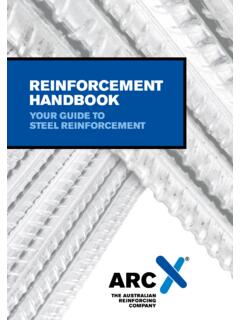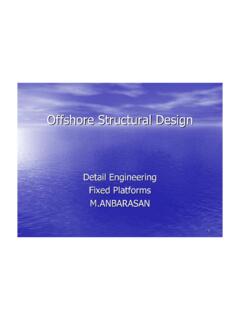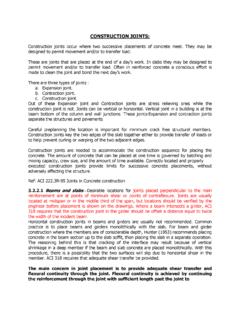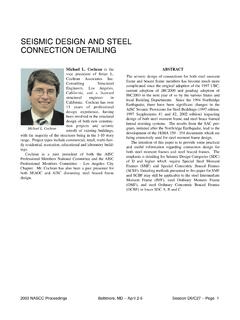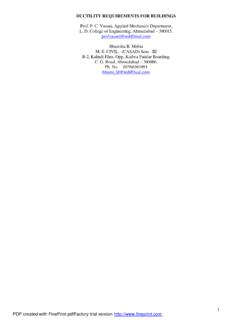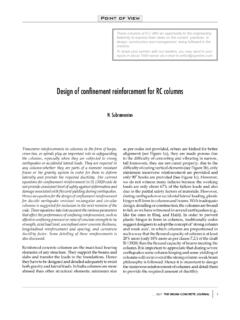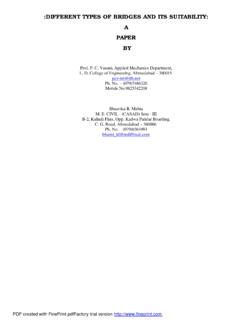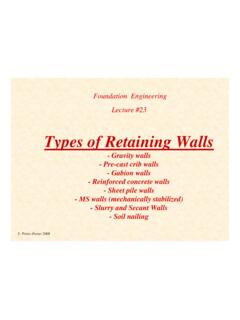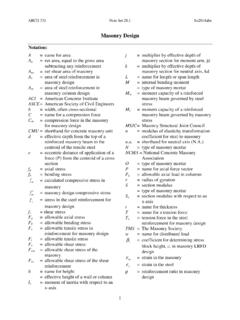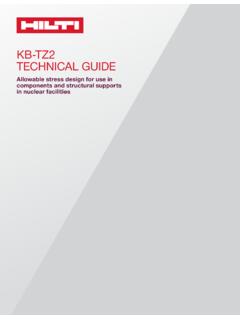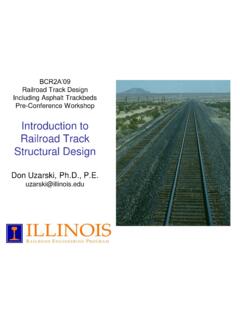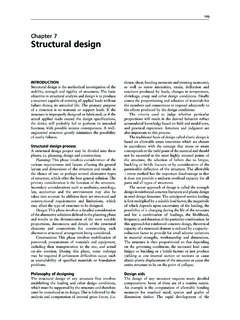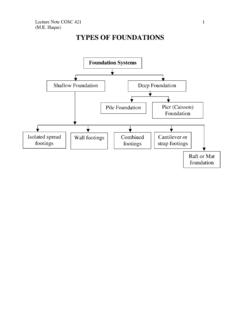Transcription of Micropiles Design 101 - Structural Engineers
1 1 Micropiles Design 101 Allen Cadden P EAllen Cadden, Chester, PALas Vegas, NV 2008 Objective Develop a background understanding of the geotechnical and Structural Design processes for Micropiles in Structural foundation support for Considerations5Bi fD i Design for Engineers Fundamentals are similar to Fundamentals are similar to traditional pile Design However, due to the small Structural section, Structural Design and stiffness can often controloften control3 Designers Must UnderstandAvailable Tools Drilling rigs Drilling rigs Drilling methods Available Structural Materials Reasonable Bond ValuesValues Quality ControlConstruction Techniques Drill Rig 4 Micropile Materials Permanent Steel Pipe API 5CT & ASTM A252 80 ksi yield Flush joint threads Steel Reinforcement ASTM A615, Gr.
2 60 & 75 ASTM A722, Gr. 150 Mechanical coupling Hollow barsCtGtStar Iron Works Cement Grout Neat cement ASTM C150 W/C ratio of 4000 psi (min)Williams FormDesign Involves: Knowing the site Knowing the site Understanding the loads Understanding the geology Calculations Specifications Specifications Quality Control5A Word on Geology Review of Geotechnical Dataobtain samples anddevelop sections obtain samples and develop sections estimate Design parameters evaluate corrosion potential identify problem areas, if anyMicropile Design Steps Internal - Structural External - Geotechnical Connection of Pile to Structure62.
3 Structural Design ComponentsCdl thCompressionTi Cased length Uncased length Grout to steel bond Transitions between reinforcement types Strain compatibilityTensionBendingCombinationsp y Casing or bar splice and connection Footing connectionStructural Design (internal)IBC 2006 code Grout & steel Transfer zone Compression Grout: f c Steel: fy max 32ksi{{IBC 2006 code allowable stresses Bond zone max 32ksi Tension Grout: 0 Steel: fy{7 allowable StressesALLOWABLE S TEELALLOWABLE GROUTC ompressionTensionS TEEL STRESS (MPa)GROUT STRESS (MPa)CASINGBARGROUTf y=550 Mpa f 'c= Mpa A SHTO Dr iv en Unf illed w ith increase for unlikely damageACI w ith LF = MicropilesAASHTO MPAASHTO Driven Concrete Filled NO increase f or unlikely damagedamage2006 IBC: c, (max 32ksi) compression.}}}
4 TensionAASHTO LRFD DesignTable - Resistance Factors forStructural Resistance of Axially LoadedMicropilesMETHOD/SOIL/CONDITIONRES ISTANCE FACTORPile Cased LengthTension, , Uncased LengthTension, , Details Shear transfer from grout Shear transfer from grout Bearing plate Shear ringsBearing PlateStiffenerConnection Strength ResearchISM 20069 Caisson Repair - Connections Controlling FactorsClL d Column Loads AccessCaissonShort Shaft, Very High LoadCaisson Repair Lower load Lower load Longer shafts10 Connection ExamplesDo we need plates?3. Geotechnical Design Evaluate Load Transfer Parameters grout to ground average bond values identify variations throughout profile and across the site define the required minimum bond length Evaluate pile spacing Evaluate pile spacing impact from group effects11 Geotechnical Design - Rational (external) FHWA th d RockBFHWAPTI method -cohesionless method - cohesive grout pressure increases bond Bruce, FHWA, PTI Based on qu local bldg.
5 Code limitsPTIbond values for gravity and pressure grouted (>50psi) anchorsGeotechnical Capacity (ASD) bbbondallowableGLDFSP = bond= grout to ground ultimate bond strengthFS = factor of safety applied to the ultimatebondstrengthbondstrengthDb= diameter of the drill holeLb= bond length 12 Calculate Bond Length Rearranging this a bitbbondallowableGbDFSPL = AASHTO LRFD DesignTable - Resistance Factors for Geotechnical Resistanceof Axially Loaded MicropilesMETHOD/SOIL/CONDITIONRESISTANC E FACTORMETHOD/SOIL/CONDITIONFACTORC ompression Resistance of Single Micropile, statSide Resistance (Bond Resistance).
6 Presumptive (1)Tip Resistance on RockO Neill and Reese (1999) Resistance and Tip ResistanceLoad TestValues in Table , but no greater than Failure, Resistance of Single Micropile, upPresumptive (1)Load Test (Type A micropile)Load Test (Types B, C, D & E Micropiles ) in Table , but no greater than Uplift Resistance, ugSand & LRFD DesignTable - Resistance Factors for Geotechnical Resistanceof Axially Loaded MicropilesMETHOD/SOIL/CONDITIONRESISTANC E FACTORMETHOD/SOIL/CONDITIONFACTORC ompression Resistance of Single Micropile, statSide Resistance (Bond Resistance):Presumptive (1)Tip Resistance on RockO Neill and Reese (1999) Resistance and Tip ResistanceLoad TestValues in Table , but no greater than Failure, Resistance of Single Micropile, upPresumptive (1)Load Test (Type A micropile)Load Test (Types B, C, D & E Micropiles ) in Table , but no greater than Uplift Resistance, ugSand & reduction in resistance factors for marginal ground or lack of redundancyLRFD Geotechnical DesignsqspqpnRRRRR +==qpqppppAqR=sssAqR=in which:( )( )where.
7 Ilii()( )Rp= nominaltipresistance(KIPS)Rs= nominal grout-to-ground bond resistance (KIPS) qp= resistance factor for tip resistance specified in Table qs= resistance factor for grout-to-bond bond resistance specified in Table unit tip resistance (KSF)qs= unit grout-to-ground bond resistance (KSF)Ap= area of micropile tip (FT2)As= area of grout-to-ground bond surface (FT2)14 Geotechnical Design EmpiricalAverage Bond Values ( allowable loads)Cl1530 kN/(12k/f) Clay: 15-30 kN/m (1-2 k/ft) Loose sands: 30-60 kN/m (2-4 k/ft) Compact sand:60-120 kN/m (5-10 k/ft) Rock: 60-240+ kN/m (5-20+ k/ft)Typical for approximately 5-7 inch pileRock Bond Values Average Rock Bond Stress ( allowable ) Shale100-600 kPa(15-85 psi) Limestone275-1000 kPa (40-150 psi) Granite/schist 300-1000 kPa (45-150 psi) Basalt 1000-1400 kPa(150-200 psi)154.
8 Additional Considerations Combined Geotechnical and Structural Settlement/Stiffness of the System Lateral Capacity deflection combined stress group effect BucklingAxial Displacement a few reminders Consider compatibility with existing fdtifoundation Elastic shortening of the pile Length (elastic) is not the total length installed Creep Structural not an issue, cohesive soils may be an issuesoils may be an issue Group Settlement16 Elastic Shortening Estimate elastic = PL / AEP For Micropiles in competent soil, L = length above bond length plus bond length For Micropiles in rock, L = full length of micropile above bond Lgplength Axial stiffness, AE, considers steel and concrete if compression loading and steel only if tension loadingAE ?
9 Evaluate for each section of pile Egrout= 1500-2500 ksi Esteel = 29000 ksi17 Lateral Capacitygeneral thoughts Micropiles do not have large lateral capacitieslarge lateral capacities Design is similar to drilled shafts and driven piles Consider combined stress effect particularly at theeffect, particularly at the threadsCombined Axial Compression and Bending Stress Pc= maximum axial compression load Pcallowable= allowable compression load Pc- allowable allowable compression load Mmax= maximum bending moment Mallowable= ( Fy S)18 LPILE 05-40 -30 -20 -10 0 10203040 Bending Moment ( ) Deflection (mm) Depth (m) (m)
10 Stiff Clay ProfileAxial Load = 1,335 kNShear Load = 54 Free HeadFixed HeadA = mm2 Scasing = mm3 Sjoint = HeadFixed HeadA = mm2 Scasing = mm3 Sjoint = mm3 Bending Moment Capacity at Threaded Connection For compression only capacity is not affected by For compression only, capacity is not affected by threaded connections For tension/bending, no codified testing procedure is available to evaluate strength at connectionCasing with twCasing thread with tw/219 Analysis of Threaded Connection Use steel yield stress (no need to limit based t itibilit )on strain compatibility) Assume casing wall thickness, tw, is reduced by 50 percent along the length of the casing joint Calculate section modulus of joint, SjointA Few Final Considerations Corrosion Protection Load Testing Quality Control Procedures Constructability Cost Effectiveness of Design205.
